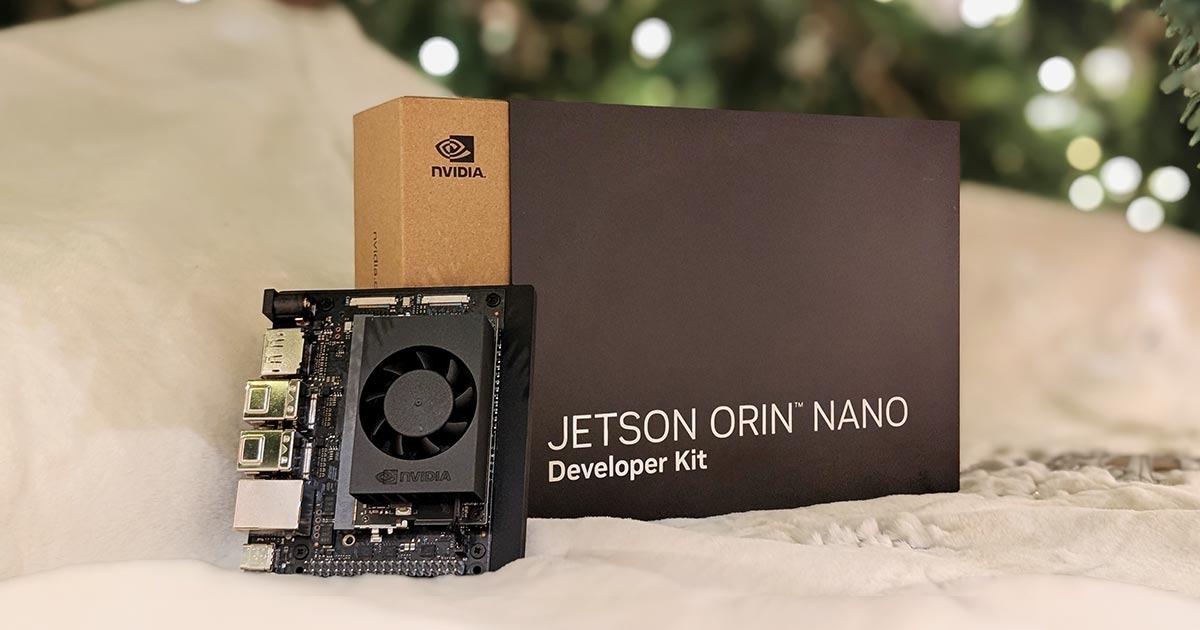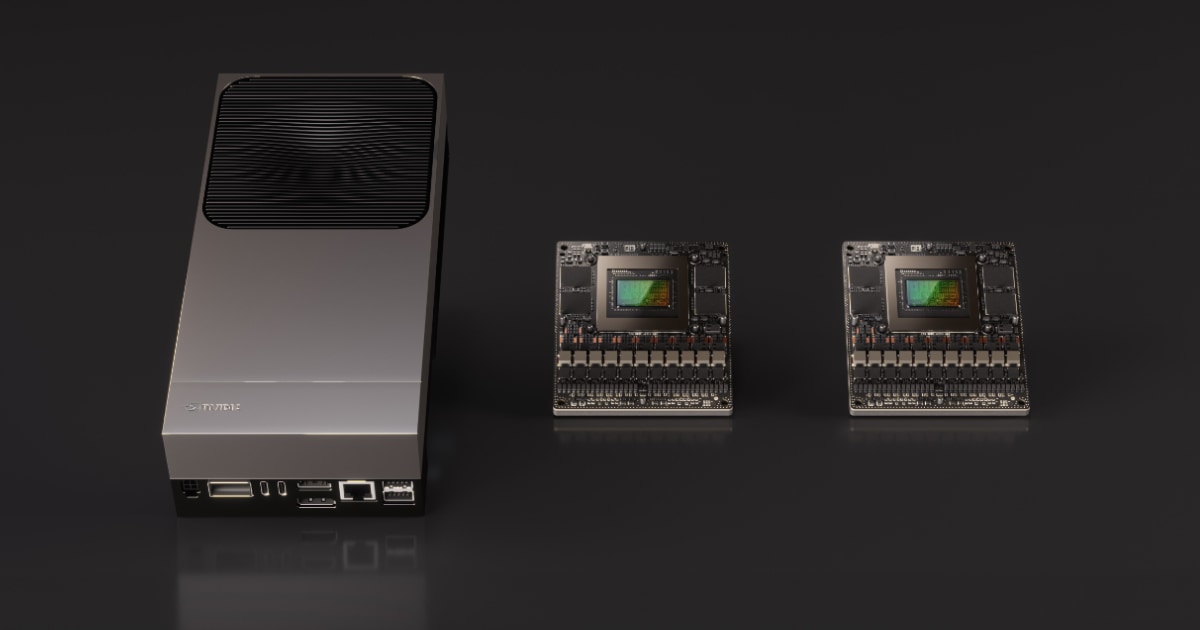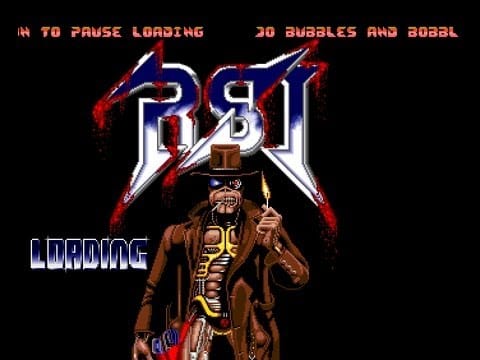NVIDIA Jetson: powerful edge AI platform for advanced robotics and embedded computing
NVIDIA's Jetson platform delivers AI computing from compact 7W modules to powerful 130W systems, enabling real-time machine learning on autonomous robots, medical devices, and industrial systems at the edge.

yippy OVERVIEW
- NVIDIA Jetson delivers AI computing platforms with modules ranging from 7W to 130W power consumption, supporting applications from hobbyist projects to industrial robotics
- The latest Jetson AGX Thor module features 2070 TFLOPS of AI performance with 128GB memory, offering 7.5x higher compute than previous generation while improving energy efficiency by 3.5x
- Platform supports complete development ecosystem through JetPack SDK, enabling deployment across healthcare, manufacturing, autonomous vehicles, and robotics industries
The latest developments in Jetson AI
NVIDIA announced the general availability of Jetson AGX Thor on August 25, 2025, marking a significant milestone in physical AI and robotics computing. The platform has attracted major industry adopters including Amazon Robotics, Boston Dynamics, Figure, Meta, and Medtronic. The developer kit, priced at $3,499, ships with the T5000 module and targets humanoid robotics applications requiring server-class performance at the edge.
In parallel, the Jetson Orin Nano received a substantial upgrade in December 2024. The refreshed "Super" variant delivers 67 TOPS of AI performance, representing a 1.7x improvement through software optimization alone. NVIDIA reduced the developer kit price from $499 to $249, making it the most affordable generative AI computer available. Existing Orin Nano users can access the performance boost through a JetPack SDK update without hardware changes.
The platform's ecosystem continues expanding, with over 2 million developers now utilizing NVIDIA's robotics software stack.
NVIDIA's combined automotive and robotics division reported $567 million in quarterly revenue
Reflecting 72% year-over-year growth as companies deploy Jetson modules across autonomous vehicles, warehouse automation, and manufacturing systems.
Edge computing demands performance without compromise. The need to process complex AI workloads directly on devices, from autonomous robots to industrial systems, has created a market for specialized hardware that bridges the gap between data centers and deployment environments. NVIDIA Jetson addresses this challenge with a platform architecture designed for real-time AI at the edge.
Platform architecture and hardware options
The Jetson platform consists of embedded computing boards built around NVIDIA Tegra processors integrating ARM architecture CPUs with GPU acceleration. The product line spans multiple performance tiers, each addressing specific deployment scenarios.
NVIDIA Jetson is a powerful platform for developing innovative edge AI and robotics solutions across industries. It delivers the compact, energy-efficient modules and developer kits with a robust AI software stack you need to deploy next-generation physical AI solutions.
Entry-level and mid-range modules
Entry-level options like the Jetson Orin Nano Super target developers and educational use cases at a $249 price point. The compact module measures 70 x 45mm and provides 67 TOPS for AI workloads through a December 2024 software update that increased performance by 1.7x. The price reduction from the original $499 makes it the most affordable generative AI computer available. The module runs large language models, vision transformers, and vision-language models, suitable for network video recorders, intelligent gateways, and prototype development.
Jetson Nano makes it possible to bring incredible new capabilities to millions of small, power-efficient AI systems. It opens new worlds of embedded IoT applications, including entry-level Network Video Recorders, home robots, and intelligent gateways with full analytics capabilities.

Existing Jetson Orin Nano Developer Kit owners can upgrade to the Super performance level through a JetPack SDK software update without hardware replacement. This software-defined performance boost unlocks generative AI capabilities including running LLMs with up to 8 billion parameters.
Mid-range Jetson Orin series modules deliver scalable performance from 67 TOPS to 275 TOPS depending on configuration. The Orin NX variants provide compact packages with high-speed sensor interfaces, while AGX Orin models offer maximum compute density for edge deployment. These modules support various power profiles, allowing developers to optimize for specific thermal and energy constraints.
Thor generation performance
Released on August 25, 2025, Jetson AGX Thor represents the platform's current flagship. Built on NVIDIA's Blackwell GPU architecture with ARM Neoverse V3AE processors, Thor targets humanoid robotics and physical AI applications requiring server-class capabilities at the edge. The developer kit sells for $3,499 and includes the T5000 module with reference carrier board.
Robotics is undergoing a revolution, moving beyond the era of specialist machines to generalist robotics. This shift moves away from single-purpose, fixed-function robots toward adaptable robots. With Jetson Thor, robots no longer need to be reprogrammed for each new job.

Computing power and memory architecture
The T5000 module configuration delivers 2070 FP4 TFLOPS with power configurable between 40W and 130W. Memory capacity doubles previous generation devices to 128GB LPDDR5X, supporting large language models and vision language models with billions of parameters. The architecture includes multi-instance GPU technology, partitioning a single physical GPU into up to seven hardware-isolated instances for parallel processing.
Connectivity and sensor integration
Connectivity infrastructure supports high-throughput sensor fusion through 4x 25GbE networking via QSFP28 interface. The module processes up to 6x 4Kp60 video encode streams and 4x 8Kp30 decode streams simultaneously, addressing applications with dense sensor arrays. Thor's Holoscan Sensor Bridge enables sub-10 millisecond latency for real-time decision requirements.
Software ecosystem and development tools
NVIDIA provides the JetPack SDK as the complete software suite for Jetson development. JetPack 7 supports CUDA 13.0 and implements Server Base System Architecture, standardizing compatibility across NVIDIA's computing platforms. This unified approach eliminates previous Tegra-specific development constraints. Over 2 million developers now use NVIDIA's robotics software stack, supported by an ecosystem of 6,000 customers and 150 partners.
To deliver a seamless cloud-to-edge experience, Jetson Thor runs the NVIDIA AI software stack for physical AI applications, including NVIDIA Isaac for robotics, NVIDIA Metropolis for visual agentic AI, and NVIDIA Holoscan for sensor processing.
Application frameworks target specific vertical markets. Isaac platform accelerates robotics development with simulation environments and foundation models. The Isaac GR00T workflow enables generalist robots capable of adapting to multiple tasks without reprogramming. Metropolis framework provides video analytics and vision AI for smart city and industrial monitoring applications. Holoscan handles sensor processing with GPU acceleration for healthcare imaging and real-time data pipelines.
Industrial applications and deployment
Manufacturing automation leverages Jetson modules for automated optical inspection and quality control systems. The platform's computer vision capabilities enable defect detection and process monitoring in real-time production environments. Industrial robots use Jetson for manipulation tasks requiring sensor fusion and adaptive control.
Major companies have adopted Jetson Thor for next-generation robotics systems. Agility Robotics integrates Thor into its Digit humanoid robot, while Boston Dynamics implements the platform in Atlas. Amazon Robotics deploys Thor for autonomous warehouse systems, and Figure utilizes the compute power for humanoid robot development. Additional adopters include Caterpillar, Hexagon, Medtronic, and Meta, demonstrating Thor's versatility across industries from construction to healthcare.
Healthcare and autonomous systems
Healthcare deployments include medical imaging devices and surgical robotics. Thor's processing capacity supports real-time analysis of high-resolution imaging data. Autonomous vehicles integrate Jetson for perception systems, with NVIDIA DRIVE AGX Thor specifically targeting automotive applications with functional safety requirements.
Logistics and warehouse automation rely on Jetson-powered autonomous mobile robots for inventory management and material transport. Retail implementations use vision AI for customer analytics and loss prevention. Smart city infrastructure deploys Jetson modules in traffic management systems and public safety monitoring.
Technical specifications and power profiles
Jetson modules implement configurable power modes allowing optimization for specific deployment requirements. The Nano operates between 5W to 10W, while Thor scales from 40W to 130W maximum. This flexibility enables developers to balance performance against thermal constraints in compact enclosures.
Video processing capabilities vary across the product line. Thor handles 8Kp30 streams and drives four independent displays. Orin series modules support multiple camera inputs with MIPI CSI interfaces, while Thor introduces Ethernet-based sensor connectivity through Holoscan. Memory bandwidth ranges from 25.6 GB/s on Nano to specifications supporting Thor's 128GB capacity.
Development and ecosystem partners
NVIDIA maintains an ecosystem of hardware partners providing custom carrier boards and integrated solutions. Companies like Antmicro develop open-source baseboards with specialized interfaces for multi-camera applications and clustering configurations. These third-party platforms extend Jetson capabilities beyond reference designs.
Software integration and training resources
Software vendors offer pre-integrated solutions for specific applications. Partner companies provide computer vision algorithms, middleware for robotics control, and deployment tools for production environments. The ecosystem includes training resources, with Jetson AI Lab providing tutorials and reference implementations for generative AI and robotics projects.

What edge AI applications would benefit most from Jetson's combination of compact form factor and high compute density? Share your thoughts with the yippy community on deployment scenarios and technical requirements.







